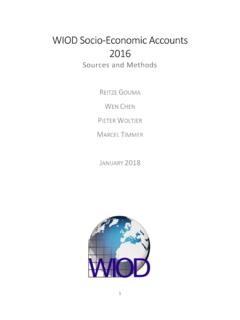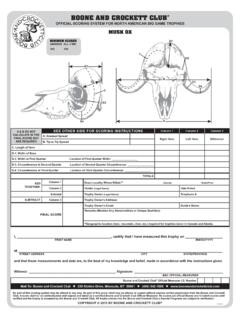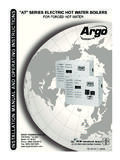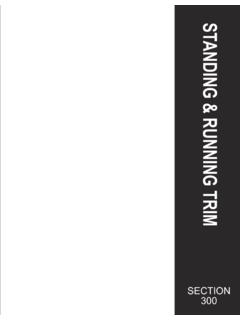Transcription of Output Database (WIOD)
1 1 The World Input Output Database (WIOD): Contents, Sources and Methods Edited by Marcel Timmer (University of Groningen) With contributions from: Abdul A. Erumban, Reitze Gouma, Bart Los, Umed Temurshoev and Gaaitzen J. de Vries (University of Groningen) I aki Arto, Valeria Andreoni Aur lien Genty, Frederik Neuwahl, Jos M. Rueda Cantuche and Alejandro Villanueva (IPTS) Joe Francois, Olga Pindyuk, Johannes P schl and Robert Stehrer (WIIW), Gerhard Streicher (WIFO) April 2012, Version This project is funded by the European Commission, Research Directorate General as part of the 7th Framework Programme, Theme 8: Socio-Economic Sciences and Humanities. Grant Agreement no: 225 281 2 Contents 1. World Input- Output Database : basic contents, set-up and construction philosophy 2. Construction of national Supply and Use tables (SUTs) 3. Sources and methods for Bilateral International Trade data 4.
2 Construction of international Supply and Use tables (Int SUTs) 5. Construction of World Input- Output Tables (WIOTs) 6. Environmental Accounts (EAs): Sources and Methods 7. Socio-economic Accounts (SEAs): Sources and Methods Appendix Tables 3 1. World Input- Output Database : basic contents, set-up and construction philosophy The World Input- Output Database has been developed to analyse the effects of globalization on trade patterns, environmental pressures and socio-economic development across a wide set of countries. The Database covers 27 EU countries and 13 other major countries in the world for the period from 1995 to 2009. It is downloadable at Basic contents of WIOD Broadly, the WIOD consists of time series of World Tables (annual, 1995-2009) International Supply and Use table at current and previous year prices, with use split into domestic and import by country (35 industries by 59 products) World input- Output table at current prices and at previous year prices (35 industries by 35 industries) Interregional Input- Output table for 6 regions (35 industries by 35 industries) National Tables (annual, 1995-2009) National supply and use tables at current and previous year prices (35 industries by 59 products) National Input- Output tables in current prices (35 industries by 35 industries) Socio-Economic Accounts (annual, 1995-2009) Industry Output , value added, at current and constant price (35 industries) Capital stock, investment (35 industries)
3 Wages and employment by skill type (low-, medium- and high-skilled) (35 industries) Environmental Accounts (annual, 1995-2009) Gross energy use by sector and energy commodity Emission relevant energy use by sector and energy commodity CO2 Emissions modeled by sector and energy commodity Emissions to air by sector and pollutant Land use, Materials use and Water use by type and sector Full lists of the variables covered can be found in the respective sections. The list of countries covered is given in Table 1. 4 Table 1 List of countries in WIOD- Database European Union North America Asia and Pacific Austria Germany Netherlands canada China Belgium Greece Poland United States India Bulgaria Hungary Portugal Japan Cyprus Ireland Romania South Korea Czech Republic Italy Slovak RepublicLatin AmericaAustralia Denmark Latvia Slovenia Brazil Taiwan Estonia Lithuania Spain Mexico Turkey Finland LuxembourgSweden Indonesia France Malta United Kingdom Russia
4 Concept of a world input- Output table (WIOT) In this section we outline the basic concept of a world input- Output tables (WIOT) and our approach in construction them. We start with the discussion of a national input- Output (IO) table. In Figure 1 the schematic outline for a national input-out table (IOT) is presented. This table is of the industry by industry type. 1 For ease of discussion we assume that each industry produces only one (unique) product. The rows in the upper parts indicate the use of products, being for intermediate or final use. Each product can be an intermediate in the production of other products (intermediate use). Final use includes domestic use (private or government consumption and investment) and exports. The final element in each row indicates the total use of each product. The industry columns in the IOT contain information on the supply of each product.
5 A product can be imported or domestically produced. The column indicates the values of all intermediate, labour and capital inputs used in production. The vector of input shares in Output is often referred to as the technology for domestic production. The compensation for labour and capital services together make up value added which indicates the value added by the use of domestic labour and capital services to the value of the intermediate inputs. Total supply of the product in the economy is determined by domestic Output plus imports. An important accounting identity in the IOT is that total Output by the domestic industry is equal to the use of Output from the domestic industry such that all flows in the economic system are accounted for. [Figure 1 about here] A world input- Output table (WIOT) is an extension of the same concept.
6 The difference with the national tables is that the use of products is broken down according to their origin. Each product is produced either by a domestic industry or by a foreign industry. In contrast to the national IOT, this information is made explicit in the WIOT. For a country A, flows of products both for intermediate and final use are split into 1 See Miller and Blair (2009) for an elaborate introduction to input- Output tables and analysis. 5 domestically produced or imported. In addition, the WIOT shows in which foreign industry the product was produced. This is illustrated by the schematic outline for a WIOT in Figure 2. [Figure 2 about here] Figure 2 illustrates the simple case of three regions: countries A and B, and the rest of the world. In WIOD we will distinguish 40 countries and the rest of the World, but the basic outline remains the same.
7 For each country the use rows are split into two separate rows, one for domestic origin and one for foreign origin. In contrast to the national IOT for country A it is now clear from which foreign industry the imports originate, and how the exports of country A are being used by the rest of the world, that is, by which industry or final end user. This combination of national and international flows of products provides a powerful tool for analysis of global production chains and their effects on employment, value added and investment patterns and on shifts in environmental pressures. While national IO tables are routinely produced by NSIs, WIOTs are not as they require a high level of harmonisation of statistical practices across countries. In the following sections we outline our efforts in constructing a WIOT.
8 World Input- Output Table (WIOT): Construction Method In this section we outline the construction of the WIOT and discuss the underlying data sources. As building blocks we will use national supply and use tables (SUTs) that are the core statistical sources from which NSIs derive national input- Output tables. In short, we derive time series of national SUTs and link these across countries through detailed bilateral international trade statistics to create so-called international SUTs. These international SUTs are used to construct the symmetric world input- Output table which is product or industry based, depending on the set of alternative assumptions used. The construction of our WIOT has two distinct characteristics when compared to the methods used by GTAP, OECD and IDE-JETRO. First, we rely on national supply and use tables (SUTs) rather than input- Output tables as our basic building blocks.
9 Second, to ensure meaningful analysis over time, we start from Output and final consumption series given in the national accounts and benchmark national SUTs to these time-consistent series. SUTs are a more natural starting point for this type of analysis as they provide information on both products and (using and producing) industries. A supply table provides information on products produced by each domestic industry and a use table indicates the use of each product by an industry or final user. The linking with international trade data, that is product based, and socio-economic and environmental data, that is mainly industry-based, can be naturally made in a SUT framework. In contrast, an input- Output table is exclusively of the product or industry type. Often it is constructed on the basis of an underlying SUT, requiring additional assumptions.
10 In Figure 3 a schematic representation of a national SUT is given. Compared to an IOT, the SUT contains additional information on the domestic origin of products. In addition to the imports, the supply columns in the left-hand side of the table indicate the value of each product produced by domestic industries. The upper rows of the SUT indicate the use of each product. Note that a SUT is not necessarily square with the number of industries equal to the number of products, as it does not require that each industry produces one unique product only. 6 A SUT must obey two basic accounting identities: for each product total supply must equal total use, and for each industry the total value of inputs (including intermediate products, labour and capital) must equal total Output value. Supply of products can either be from domestic production or from imports.





